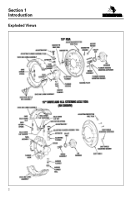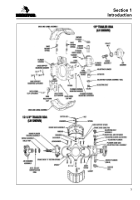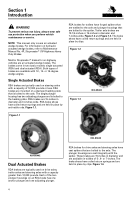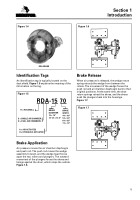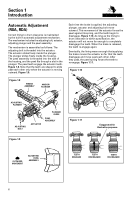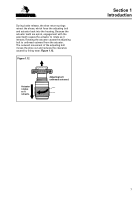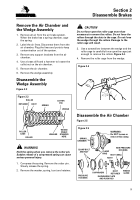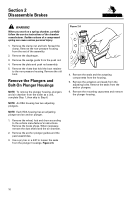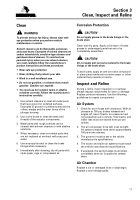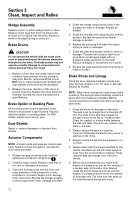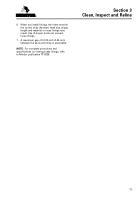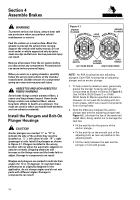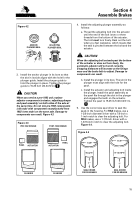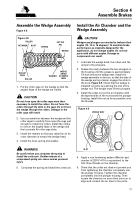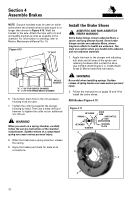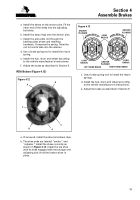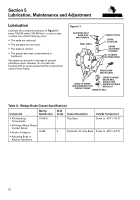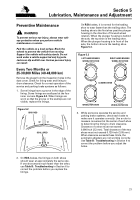MERITOR-TP-9853 - Page 16 of 32
Section 3
Clean, Inspect and Reline
12
Wedge Assembly
Replace a worn or pitted wedge head or rollers.
Replace a bent cage that does not allow roller
journals to fit properly into the slots. Replace a
weak or damaged spring or cotter pin.
Brake Drums
CAUTION
Do not operate the vehicle with the brake drum
worn or machined beyond the discard dimension
indicated on the drum. The brake system may not
operate correctly. Damage to components and
serious personal injury can result.
1. Replace a drum that has cracks, severe heat
checking, heat spotting, scoring, pitting or
distortion. Meritor recommends that you do
NOT
turn or rebore brake drums. Strength and
heat capacity of the drum will be decreased.
2. Measure the inner diameter of the drum at
several locations. Replace the drum when the
diameter exceeds the drum manufacturer’s
specifications.
Brake Spider or Backing Plate
All mounting bolts must be tightened to the
vehicle manufacturer’s specifications. Replace
distorted spiders or backing plates. On RSA
brakes, replace worn anchor pins.
Dust Shields
Repair or replace damaged or distorted dust
shields.
Actuator Components
NOTE:
Actuator parts and seals are critical brake
parts. Replace scored, damaged or excessively
worn parts and seals.
1. Plunger housing mounting bolts must be
tightened to 30-40 lb-ft (41-54 N•m).
2. Carefully inspect seals. Replace a seal that is
cut, torn or damaged in any way.
3. Check the housing bores and the inner and
outer diameters of the plungers for nicks,
scratches or corrosion. Repair minor damage
with crocus cloth. Replace the plunger housing
or the plunger when major damage is evident.
4. Check the wedge ramps and all slots in the
plungers for wear or damage. Replace as
needed.
5. Check the threads of the adjusting bolt and the
actuator. Replace the parts when thread
damage is evident.
6. Replace the adjusting bolt when the detent
spring is loose or damaged.
7. Check the pawl and actuator teeth for wear or
damage. The pawl and actuator teeth must
have sharp, undamaged edges with no
displaced metal anywhere on the teeth.
Replace damaged or excessively worn parts.
8. Replace the pawl assembly when the spring is
weak or broken.
Brake Shoes and Linings
Check the shoe retaining hardware (guide pins,
clips, springs, washers, etc.) for wear or damage.
Replace as needed.
NOTE:
Weak return springs can cause many brake
problems. The springs must completely retract the
shoes when the brakes are released. Meritor
recommends that you install new return springs at
each reline.
1. Check the shoes for damage or distortion.
The web must be straight and not twisted off
line. The ends of the web that engage the
plungers must not be flat or “mushroomed.”
Check for cracked or broken welds between
the web and table. Check for any cracks in the
table or the web.
2. Always replace linings worn past the
minimum thickness indicated by the groove or
scallops in the lining.
3. Always replace linings that have grease or oil
on them.
4. Always reline with the linings specified by the
vehicle manufacturer. Vehicle brake systems
must have the correct friction material. These
requirements can change from vehicle to
vehicle.
5. Meritor recommends that you reline both
wheels of a single axle, and all four wheels of
a tandem axle, at the same time. Always
install the same linings and drums on both
wheels of a single axle and on all four wheels
of a tandem axle. The front and rear axles do
not need the same linings and drums.
Back to Top

